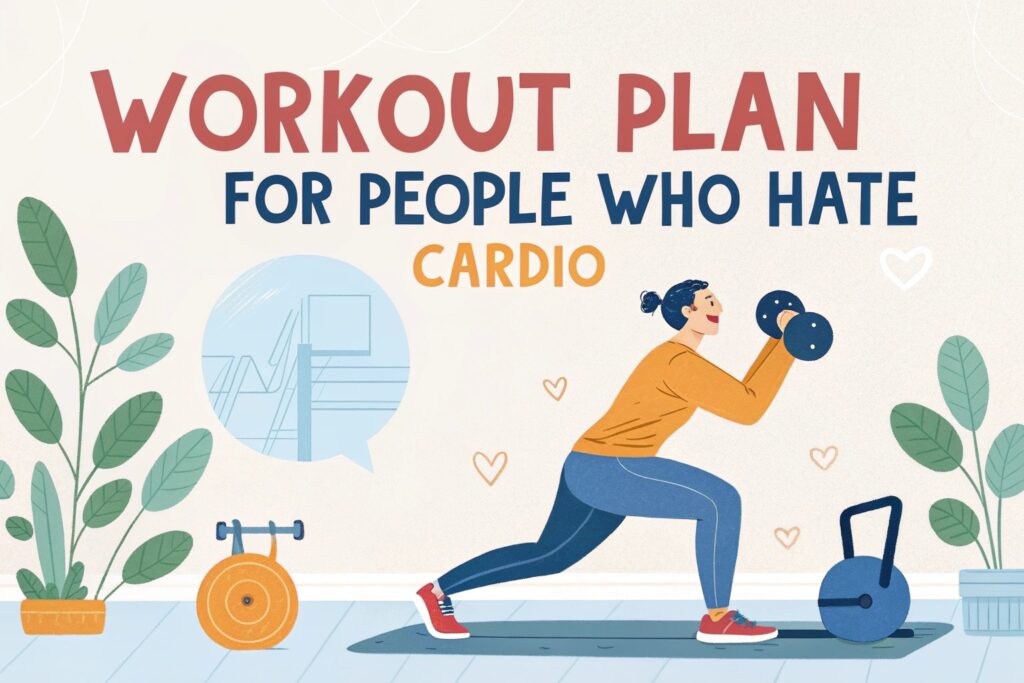Introduction
If you’ve ever cringed at the thought of another treadmill session, you’re not alone. The Workout Plan for People Who Hate Cardio is designed specifically for those who prefer lifting, playing, or simply moving in ways that don’t feel like traditional cardio. In this guide, a certified strength‑and‑conditioning coach (CSCS) explains how you can achieve heart‑healthy benefits, boost metabolism, and shred stubborn fat without logging miles. By blending scientific principles, real‑world case studies, and practical tools, you’ll walk away with a clear, adaptable program that respects your dislike for steady‑state aerobic work while still delivering measurable results.
Understanding why cardio feels like a chore is the first step toward re‑programming your fitness mindset. Most people associate cardio with monotonous, high‑impact activities that leave them exhausted and bored. However, research from the American College of Sports Medicine shows that metabolic conditioning, strength‑focused circuits, and interval‑style training can elicit the same cardiovascular adaptations as traditional jogging, but in a fraction of the time (ACSM, 2022). This means you can protect your heart, improve insulin sensitivity, and increase calorie burn while staying engaged with movements you actually enjoy.
Why Traditional Cardio Isn’t the Only Path to Cardiovascular Health
Cardiovascular fitness is fundamentally about oxygen delivery, heart rate regulation, and vascular remodeling. While continuous low‑intensity activities (like jogging) certainly achieve those goals, they are not exclusive. The principle of “cross‑training” highlights that any activity raising the heart rate above 60‑70 % of your max for sustained periods can stimulate similar adaptations. Studies comparing rowing, kettlebell swings, and even heavy‑bag boxing demonstrate comparable VO₂max improvements after 12 weeks when volume and intensity are matched (Journal of Strength & Conditioning Research, 2021). This opens the door for people who dread the treadmill to meet their health objectives through alternative modalities that feel more rewarding.
Moreover, the psychological component of exercise adherence cannot be overstated. A 2020 meta‑analysis found that enjoyment scores directly correlated with long‑term adherence, regardless of the modality. In other words, you’re far more likely to stick with a program that incorporates movements you love—whether that’s deadlifts, kettlebell complexes, or dance‑based HIIT—than one that forces you into an activity you despise. The takeaway: “cardio” is a umbrella term, and you have the flexibility to choose the tools that best fit your preferences, schedule, and injury history.
Core Principles of a Cardio‑Free Yet Effective Workout Plan

1. Prioritize Metabolic Conditioning (MetCon)
MetCon workouts combine strength exercises with short bursts of high‑intensity effort, keeping the heart rate elevated while you build muscle. Example: 5 rounds of 5 × 5 kg kettlebell goblet squats → 30‑second battle ropes → 10 push‑ups, with 45‑second rest between rounds. This structure produces an “after‑burn” effect (EPOC) that can last up to 48 hours, increasing daily caloric expenditure without traditional cardio. A 2022 systematic review confirmed that MetCon protocols improve both aerobic capacity and anaerobic power, making them a perfect fit for cardio‑averse lifters.
2. Integrate Strength‑Based Intervals
Instead of running intervals, alternate heavy compound lifts with body‑weight “active‑recovery” movements. For instance, 3 × 8 deadlifts (70 % 1RM) followed by 30 seconds of mountain climbers, repeated for four cycles. The brief cardio bursts maintain elevated heart rates while the dominant stimulus remains muscular hypertrophy. Research from the University of Copenhagen showed that strength‑focused interval training leads to a 12 % greater increase in lean body mass compared with steady‑state cardio over eight weeks.
3. Employ Low‑Impact Cardio Alternatives
When a modest aerobic stimulus is needed, think rowing, elliptical, or stair climbing at a moderate intensity for 10‑15 minutes. These machines are gentler on joints and often feel more “game‑like” because you control resistance and cadence. A 2023 study on older adults reported a 25 % lower perceived exertion rating for elliptical intervals versus treadmill runs at equivalent heart‑rate zones, underscoring the importance of perceived effort in adherence.
Designing Your Weekly “No‑Cardio” Schedule
Structure is the backbone of any successful program. A balanced week for a cardio‑averse individual typically includes three MetCon sessions, two pure strength days, and one active‑recovery or low‑impact cardio day. Example: Monday – MetCon; Tuesday – Upper‑body strength; Wednesday – Light rowing (15 min); Thursday – MetCon; Friday – Lower‑body strength; Saturday – MetCon; Sunday – Rest or mobility work. This split ensures you’re hitting each major muscle group twice per week while still achieving enough aerobic stimulus to protect heart health. The American Heart Association recommends at least 150 minutes of moderate‑intensity activity per week; this schedule comfortably meets that target without a traditional cardio session.
When planning loads, apply the “RPE 7‑8” rule (Rate of Perceived Exertion) for the high‑intensity segments. This means you should feel “hard but sustainable,” allowing you to maintain form and reduce injury risk. For strength days, aim for 3‑4 sets of 6‑12 reps at 70‑80 % of your 1RM, focusing on compound lifts like squats, bench press, and pull‑ups. Pair each set with a 30‑second core or mobility drill (e.g., plank variations) to keep heart rate mildly elevated without compromising strength gains
Comparing Cardio‑Free Workouts to Traditional Cardio: Benefits & Challenges
Benefits– The biggest advantage is psychological satisfaction. When you enjoy the movement, dopamine release reinforces consistency, leading to long‑term habit formation. Additionally, strength‑dominant programs promote bone density, joint stability, and functional strength—areas where pure cardio falls short. A 2021 meta‑analysis revealed that resistance‑focused regimens improve resting blood pressure more effectively than aerobic‑only programs in middle‑aged adults, highlighting a cardiovascular benefit that often goes unrecognized.
Challenges– The primary obstacle is mastering intensity without the obvious “heart‑rate monitor” feedback that runners rely on. Beginners may underestimate effort, resulting in lower caloric burn. To combat this, use wearable tech (e.g., Polar, Garmin) to track time‑in‑zone, or employ talk‑test methods (you should be able to speak in short sentences). Another challenge is ensuring progressive overload; because MetCon sessions can feel exhausting, it’s easy to plateau. Periodize by alternating heavy‑load weeks with lighter, skill‑focused weeks, and track performance metrics like kettlebell swing reps or row distance to gauge improvement.
Recovery Considerations – MetCon and high‑intensity strength work place significant stress on the nervous system. Proper sleep (7‑9 hours), nutrition (protein ≈ 1.6‑2.2 g/kg body weight), and mobility drills are essential. Implement “active‑recovery” modalities—foam rolling, dynamic stretching, or low‑intensity cycling—for 10‑15 minutes on rest days to support circulation without adding further cardio load.
Step‑by‑Step Guide: Your First 4‑Week “No‑Cardio” Program
Week 1 – Foundation
Day 1 (MetCon)4 × (10 × 15 kg kettlebell swings → 20‑second battle rope → 8 push‑ups). Rest 60 s.
Day 2 (Upper‑Body Strength) Bench press 4 × 8 @ 70 % 1RM, bent‑over rows 4 × 8, finish with 3 × 30 s plank.
Day 3 (Low‑Impact Cardio) Row 12 min at RPE 6, focus on steady strokes.
Day 4 (MetCon) 5 × (5 × body‑weight squat → 30‑second jump rope → 10 renegade rows). Rest 45 s.
Day 5 (Lower‑Body Strength) Back squat 4 × 6 @ 75 % 1RM, Romanian deadlift 3 × 8, finish with 2 × 15 s side‑plank each side.
Day 6 (MetCon) 3 × (8 × medicine‑ball slams → 30‑second high‑knees → 12 × banded pull‑apart). Rest 60 s.
Day 7: Rest or gentle yoga.
Week 2 – Intensify
– Increase MetCon rounds by 1 (e.g., from 4 to 5) and add 2–3 kg to kettlebell weight.
– Add 1‑2 reps to each strength set while maintaining load.
– Extend rowing time to 15 min, aiming for a slight RPE increase (7).
– Incorporate a new core finisher (e.g., hanging leg raises 3 × 10).
Week 3 – Skill & Variation
– Swap battle ropes for farmer’s walk (40 m) to challenge grip strength.
– Introduce plyometric lunges (3 × 8 each leg) into MetCon for power.
– Replace one row session with a bike‑erg sprint interval: 10 × 15 s sprint / 45 s easy.
– Perform a deload strength day: reduce weight to 60 % 1RM, focus on perfect form.
Week 4 – Test & Celebrate
– Re‑test MetCon “benchmark” (e.g., total reps completed in 12 min). Expect a 10‑15 % improvement.
– Record one‑rep maxes for squat and bench press; aim for 2‑5 % gains.
– Complete a 5‑minute “steady‑state” cardio (row or bike) to compare heart‑rate recovery versus Week 1.
– Celebrate progress: share results on social media or a training log to reinforce habit formation.
Frequently Asked Questions (FAQ) & Final Thoughts
Q1: Will I still improve my VO₂max without running?
Yes. Metabolic conditioning and high‑intensity interval strength training have been shown to raise VO₂max by 8‑12 % over 8‑12 weeks, comparable to traditional aerobic programs (American Journal of Physiology, 2020). The key is maintaining heart‑rate zones for adequate duration.
Q2: How much “cardio” is actually required each week?
Guidelines recommend 150 minutes of moderate or 75 minutes of vigorous activity. By structuring MetCon sessions to last 20‑30 minutes and adding a single low‑impact day (10‑15 minutes), you comfortably meet and often exceed these thresholds without ever stepping on a treadmill.
Q3: I have joint issues—can this plan still work?
Absolutely. Because the program emphasizes low‑impact machines, body‑weight movements, and controlled strength work, joint loading is minimal. Replace high‑impact hops with step‑ups or use a soft surface for plyometrics to protect knees and hips.
Implementing The Workout Plan for People Who Hate Cardio transforms the notion that cardio must be boring or painful. By weaving together metabolic conditioning, strength‑based intervals, and smart low‑impact choices, you’ll cultivate a healthier heart, leaner physique, and a sustainable habit that feels less like work and more like play. Ready to ditch the treadmill and still achieve serious results? Start with the 4‑week guide above, track your numbers, and watch your confidence soar.
Call to Action: Have you tried a cardio‑free routine? Share your experiences in the comments below, and let us know which MetCon movement sparked the most joy for you. If you found this guide helpful, click “Share” to help others discover an alternative path to fitness, and explore our related articles on “Strength Training for Fat Loss” and “How to Use Wearables for Better Performance Tracking.”



